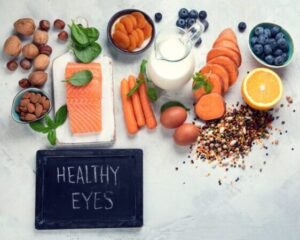
In May, the flowering pollinators of April send many allergy sufferers running for over-the-counter anti-histamine eyedrops to remedy itchy, watery eyes. During this seasonal change, practicing good eye health can center narrowly around taking OTCs and discussing symptoms management with one’s PCP. May is therefore a timely month to address eye health not only as mitigating symptoms, but also as a matter of integrating preventive healthy behaviors into one’s personal routines to preserve vision and protect our eyes year-round.
The American Academy of Ophthalmology (AAO) has designated May as Healthy Vision Month. As Americans embrace springtime’s farm and garden bounty of strawberries, asparagus, salad greens and more, May provides a “ripe” opportunity to overview behaviors that positively impact eye health before summer leisure can lead to lapses in good nutrition and personal practice.
Good Nutrition = Strong Eye Health
Adopting a healthy lifestyle is the greatest self-investment that aging adults can make to reduce odds of developing eye disease. Reducing risk of developing ocular disease begins with adopting good nutrition by early adulthood. Adopting plant- and seafood-based diets are a major step in the right direction. Other compounds found in nutrient-rich foods good for ocular and overall body health include:
- Antioxidants: Studies have shown that an anti-oxidant-rich diet can slow the development of cataracts through blocking changes in fats and proteins that progressively cloud the eye’s lens. Foods rich in Vitamins A, C and E, carotenoids, lutein and zexanthin, and selenium are rich in antioxidants, which slow cell death (oxidation) that accelerates aging. Berries, nuts, spinach, sweet potatoes and broccoli are some foods loaded with omega-3 fatty acids.
- Omega-3 fatty acids: Research shows that diets high in omega-3 fatty acids alleviate symptoms and reduce risks of developing chronic ocular conditions including dry eye disease (DED), age-related macular degeneration (AMD) and glaucoma. Diets full of these polyunsaturated fatty acids greatly benefit ocular health and also slow aging through lowering inflammation and cortisol levels and boosting the body’s repair mechanisms. Cold-water fatty fish (salmon, mackerel, tuna), walnuts, seeds (flaxseed, chia seeds), plant oils are some foods rich in omega-3 fatty acids.
- Carotenoids: Pumpkin, grapefruit, carrots, bell peppers, leafy greens, eggs, broccoli, tomatoes
- Lutein and zeaxanthin: Leafy greens (kale, spinach, and swiss chard), orange-yellow vegetables, broccoli, asparagus, colorful fruits (raspberries, papaya, peaches)
- Selenium: Whole or multi-grain pasta and bread, oatmeal, brown rice
- Vitamin A, C, E: Avocados, bananas, oranges, sunflower seeds
- Zinc: Legumes (beans and lentils), seeds, seafood, dairy, eggs
Prevention and Preparedness are Key to a Healthy Lifestyle!
- Exercise IS Key to Ocular Health! Regular exercise helps individuals prevent obesity that leads to many serious chronic conditions, including eye diseases like diabetic retinopathy, wet macular degeneration and glaucoma.
- Quit Smoking & Moderate Alcohol Intake Two modifiable health behaviors – smoking and drinking – are heavily associated with higher risk of developing chronic disease, including all serious eye diseases. By mid-life, adults should quit smoking and avoid second-hand smoke, as well as moderate or quit alcohol intake, to optimize long-term health.
- Eye Exams Are Chronic Disease Detectives! Eyes reveal how blood vessels, nerves and connective tissues system-wide are functioning. Routine eye exams are critical for ocular health and offer a “free pass” for detecting a range of neurological, cardiac, cancer and other conditions before symptoms appear. Read the AAO’s 20 Surprising Health Problems an Eye Exam Can Catch to learn more.
- Know Family History of Eye Disease. Discuss family history, ethnicity and other health issues with your ophthalmologist at a comprehensive eye exam and with your primacy care provider at well check exams to identify risk factors for developing serious eye diseases.
- Take Care of Your Eyes When Traveling. Preparedness is key to healthy living and key to travel.
- DO NOT WAIT until back home to seek medical attention when eye injuries/emergencies occur while traveling. Eye trauma can lead to permanent loss of vision if not treated immediately. An international list of all AAO ophthalmologist members is available at Find an Ophthalmologist.
- Glasses wearers should pack two pairs on every trip. Contact wearers should pack lens cases and two bottles of lens solution in carry-ons for relieving drier eyes while in flight. Remove contacts if sleeping several hours in flight.
Lifestyle, not perfection, is key to good lifelong health. The key to practicing good eye health is taking action. Around age 40, all adults begin to experience degrees of diminished ocular function, such as loss of ability to focus on objects up close due to hardening of the eye’s lens (presbyopia). By age 40, asymptomatic adults should have a comprehensive eye exam. Call UNC Kittner Eye Center at 984-974-2020 today to schedule your comprehensive eye exam with a UNC Ophthalmology eye specialist. Read the AAO’s 21 Ways Aging Changes Your Eyes to learn more on changes in the eyes that come with age.
In July 2020, UNC Assistant Professor of Ophthalmology and lead optometrist Michael Mendsen, OD, was interviewed by UNC Health Talk for a discussion entitled, “Anatomy of an Eye Exam.” In this interview, Dr. Mendsen addressed comprehensive eye exams as a critical component of practicing good eye health. He emphasized how screening to identify signs of early-stage development of eye disease is equally as important as visual acuity, refraction and other types of testing in evaluating asymptomatic adults in comprehensive eye exams.
#HealthyVisionMonth! @academyeyesmart
#ophthalmology #eyes


